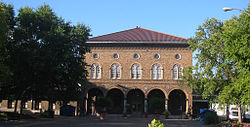Soulard, St. Louis
Soulard | |
|---|---|
Neighborhood of St. Louis | |
 The Soulard Market in the northern portion of the Soulard neighborhood. | |
 Location (red) of Soulard within St. Louis | |
| Country | United States |
| State | Missouri |
| City | St. Louis |
| Wards | 7, 9 |
| Area | |
| • Total | 0.60 sq mi (1.6 km2) |
| Population (2020)[1] | |
| • Total | 3,831 |
| • Density | 6,400/sq mi (2,500/km2) |
| ZIP code(s) | Part of 63104 |
| Area code(s) | 314 |
| Website | stlouis-mo.gov |
Soulard (/ˈsulɑːrd/ SOO-lard) is a historic neighborhood in St. Louis, Missouri.
It is named for Antoine Soulard and Julia Cérre Soulard. Antoine Soulard first began to develop the land given to him by his father-in-law, Jean-Gabriel Cerré.[2] Soulard was a surveyor for the Spanish government and a refugee from the French Revolution in the 1790s.[3]
One of the oldest communities in the city, Soulard is today a largely residential neighborhood whose many businesses include restaurants, bars, and the North American headquarters of Anheuser-Busch, which houses the St. Louis Brewery. Half of the neighborhood north of Lynch Street is composed mostly of row homes and small apartments, with the Anheuser-Busch Brewery and headquarters occupying most of the land south of Lynch. Many of its houses date to the mid- to late-19th century. Soulard also has several historic churches.[4]
Many of its bars host live music, especially the blues and jazz bands for which the city is known. The barrelhouse blues piano player James Crutchfield lived in the neighborhood from 1984 until his death in 2001 and performed in many of the nightclubs. The district hosts regular pub crawls.
There are various neighborhood groups, including the Soulard Restoration Group and the Soulard Business Association, that organize events, keep the neighborhood clean and safe, and publish a newspaper, The Soulard Renaissance.

It is home to Soulard Farmers Market, the oldest farmers market[5] west of the Mississippi. More than a hundred vendors include farmers, produce vendors, meat shops, spice shops, florist shops, and food.
Soulard Market is featured in the opening scene of Alan Schroeder's picture book Ragtime Tumpie.
Events[]
Soulard hosts many events throughout the year, including celebrations of Mardi Gras and Oktoberfest.
Soulard hosts the St. Louis Mardi Gras festival, which sometimes attracts hundreds of thousands of revelers, largely depending on the weather.[6] It has been said that St. Louis hosts the second-largest Mardi Gras party in the U.S.[7]

Like the New Orleans celebration, the Soulard version features several parades during the Mardi Gras season. On the second Sunday before Mardi Gras, there is a family-oriented pet parade dubbed "Krewe of Barkus," which features people and costumed pets. The parade is followed by the informal Wiener dog races. On the Saturday evening before Fat Tuesday, the more adult-oriented flesh-for-beads parade occurs, although there have been various attempts to reserve a family section at one end of the route. The east-west streets of Soulard, Geyer, Allen, Russell, and others are crowded with people from 7th to 12th Street. Several VIP tents are available for admission by a fee, and, usually, a national recording artist performs for free on the main stage, usually on 7th St. In recent years, the parade has been moved just north of Soulard to downtown St. Louis.
Demographics[]
| Year | Pop. | ±% |
|---|---|---|
| 1990 | 3,771 | — |
| 2000 | 3,187 | −15.5% |
| 2010 | 3,440 | +7.9% |
| 2020 | 3,831 | +11.4% |
| [8][9] | ||
In 2020, Soulard's population was 75.2% White, 15.8% Black, 0.2% Native American, 1.1% Asian, 0% Pacific Islander, 1.5% from some other race, and 6.0% from two or more races. 4.3% of the population was of Hispanic origin.
Gallery[]

The Anheuser-Busch and Lemp brewery buildings and Soulard in south city near the Mississippi River, 2006

A two-family home in Soulard, around 2006

Stars are a common architectural motif from the era of Soulard's building, an anchor plate on brick.

Pedestrians on South Eighth St., around 1910
See also[]
- Anzeiger des Westens, the former large German-American daily newspaper of St. Louis, and the politically charged riot related to its readership that took place in Soulard
- Lafayette Square, St. Louis, a grand nearby neighborhood
- LaSalle Park, a former area of the neighborhood divided off by the construction of highways
- Missouri Rhineland, a major winemaking area in the region, both past and present
References[]
- ^ 2020 Census Neighborhood Results
- ^ Souvay, Charles Léon; Rothensteiner, John Ernest (1922). St. Louis Catholic Historical Review. Catholic Historical Society of Saint Louis. p. 9.
- ^ "Outdoor Market: Soulard Center Attracts Saturday Crowd of Experienced, Careful Food Shoppers". St. Louis Post-Dispatch. 1945-12-16. p. 89 – via Proquest.
- ^ "St. Louis - Historic Soulard". Slfp.com.
- ^ "Soulard Farmers Market Home". Soulardmarket.com.
- ^ "Soulard Mardi Gras 2020 | St. Louis, MO". Stlmardigras.org.
- ^ [1][dead link]
- ^ "Census". Dynamic.stlouis-mo.gov.
- ^ "Soulard Neighborhood Statistics | 1990 Census". Stlouis-mo.gov.
Sources[]
- "National Register of Historic Places - Nomination Form" (PDF). Missouri Department of Natural Resources. Retrieved 2008-05-30.
External links[]
- Soulard.org Soulard Restoration Group - the neighborhood association of Soulard
- Soulard at St. Louis Front Page.com
- Mardi Gras Inc., Organizers of St. Louis Mardi Gras
- Soulard Farmers Market
- Soulard Market Official Site
- The Lemp Mansion
- iLoveSoulard.com
- French-American culture in Missouri
- Landmarks of St. Louis
- Neighborhoods in St. Louis
- French colonial settlements of Upper Louisiana




